for more pictures: http://www.flickr.com/photos/silkroadproject/sets/72157600046975805/

Sultan Kaze – Sound Innovator and Instrument Maker
Two Mornings with Sultan Kaze in the Yili Kazak Autonomous Region
Born in 1965, Sultan Kaze is a craftsman dedicated to the revival and development of Kazakh music. He has crafted and revived many of Kazakh’s most traditional instruments, and used these instruments to develop and invent others. He is an experimenter of sound histories. His works are exposed in the Illi Museum for Kazakh Culture.
Sultan Kaze studied at the Illi Music and Dance Troupe and in 1992 was named its director. First learning how to play to Dömbra, he quickly started to be interested in more ancient Kazakh instruments. An assiduous researcher, he gathered all the available literature in Illi and across the border in Kazakhstan, but found few materials on ancient instruments. Only one foreign book (he did not state it origin- probably Kazakhstan) published in 1978 enabled him to learn about the various types of instruments and how they were made. The book provided only a structure – and Sultan Kaze was left to improvise and investigate in his basement workshop below his apartment. He was determined to revive the instruments he saw – and his investigations were instinctual, he says.

Sultan Kaze is a historian and an inventor, a storyteller with agile and constructive hands. He has dived into wood and strings, experimenting with revival and histories.
Pulling from old pictures, he is rebuilding the past and innovating on sound.
He is a deep well of history – he has lived for these instruments and culture since the days of China’s reform.
Kybyze
Sultan Kaze first crafted the Kazakh’s traditional Kybyze, a two-stringed violin – which is set on the musician’s lap and played vertically with a horse-tail bow. The hollow body of the classical Kybyze is covered with camel or cowhide and the strings are made of naturally processed sheep intestines. After finishing his Kybyze, he felt that the notes and musical range of the Kybyze were restricted, finding its low tone too monotone an unvaried.

(photo: Sultan Kaze with ancient Kybyze. Kybyze means instrument in Kazakh)
He investigated methods to make the Kybyze more alive, and more adapted to today’s new sounds – he wanted to be able to play both Kazakh and foreign music.
From his investigations, the modern Kybyze was born. Maintaining the same shape and structure, he added two more strings to increase the range of the instrument, and covered the hollow with wood (rather than camel-hide) to help make a more stable sound (not dependent on the caprices of the changing seasons – their humidity or dryness). The new four-stringed Kybyze now gave musicians access to a greater musical repertoire, while conserving the sounds and effects needed to play traditional Kazakh songs. Sultan Kaze proudly states that the new modern Kybyze is successfully performed and starting to develop among the community.
Zhitegen: Kings, Sons and Seven Strings
Sultan Kaze’s experimenting did not stop here. Building on the success of his modern Kybyze, Sultan Kaze revived and transformed the Kazakh Zhitegen – or “seven strings”. He knew of the Zhitegen only in books. The instrument had died away and had not been used for the length of memory. Noone recalled the sound, until the 1938 excavation of a burial ground in southern Kazakhstan were the remains of an old Zhetigen were found.

From pictures and descriptions, he revived the instrument – again in his compact basement workshop.
The Zhitegen, he tells us has a magic history:
The Zhitegen was born in myth and chaos, in the time when the wide open plains were continuing their path in life and death, peace and war. One year on the plain the cold came crashing to the land, bringing with it an epidemic that swept through the population.
One leader of the tribe, a rich man dotted with seven sons was to be hard hit by the snows and disease.
The epidemic entered the leader’s tent, striking his first son. Shattered and heartbroken by this death, the old man nailed a string across his Zhitehan board. Zhitehan, or “Seven Kings” was a traditional dice game played on a large wooden board with colored sheep knuckles (small curved bones). With this string of remembrance stretched across his game board, he could no longer play and be merry without remembering his son.
But the epidemic was not to leave so soon, and rapidly slayed a second of his sons. The old man, in remembrance lays another string across the wooden board. But the epidemic was well entertained in his house and rapidly spread through all his progeny, slaying all of his seven sons. For each of his sons, the old man nailed a string across his Zhitehan board, and soon the game board was flush with seven strings.
Out of desperation, wishing his sons back to people his tents and encampment, the old man caressed the strings longing for their return. As he touched the strings (probably made of mutton intestine or wool) he realizes that they make beautiful sound. The old man is enchanted - his sons are there – speaking with him through the strings. The strings have become their memory, and the old man starts plucking the strings into melodies of sadness and recollection. Thus the Zhitegen “Seven Strings” was born.
The Zhitegen strings are held up above the wooden board by mutton bone knuckles – probably the same ones used in the Zhitehan game.


(photo: both Sultan Gaze and his wife are masters of creation, reflecting eachother)
Kazakh and Chinese Fusion: the New Zhitegen
After reviving the Zhitegen, the innovative Sultan Kaze had to go further. He could not help but notice the similarities between the Zhitegen (a horizontal harp) and the traditional Chinese horizontal harp, the Guqin. He thus developed a new Zhitegen with 18 strings (some plastic, metallic, and some still made of sheep intestines) and again an extended range of sounds and possibilities.

(photo: Sultan Kaze with old (right) and new (left) Zhitegen)
It is the same board, with a variation on scales.
He is still working on the sounds possible with this instrument – whose strings are held above mutton bone knuckles like the traditional Zhitegen. Song Yu Zhi enthusiastic about this musical investigation suggested many other possibilities – such as using the same strings as used in traditional western harps – and Sultan Kaze’s investigations may further see interesting developments.




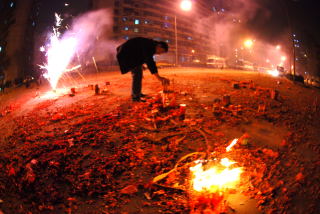
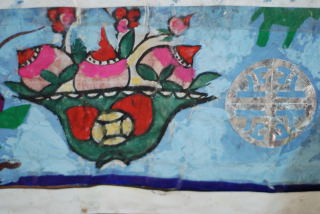

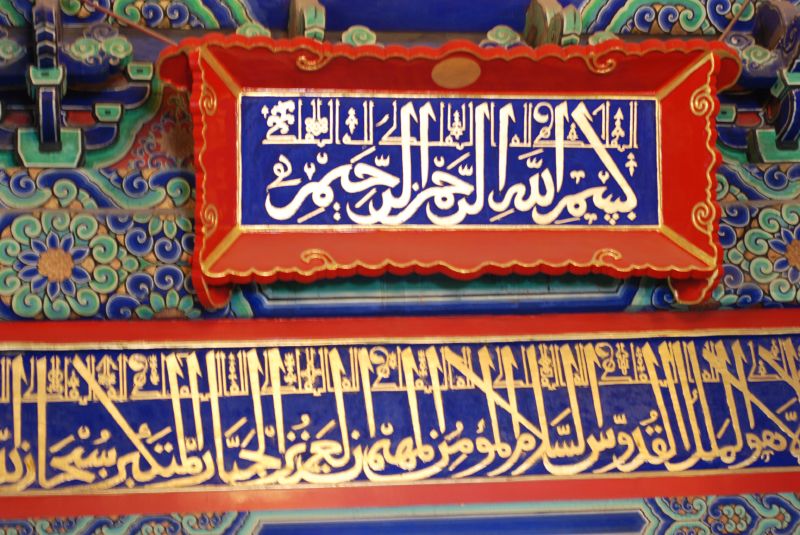

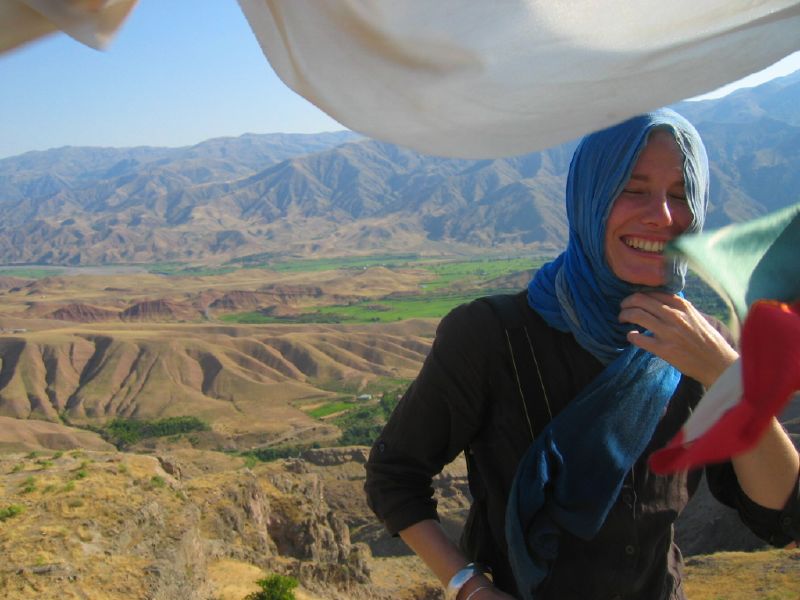
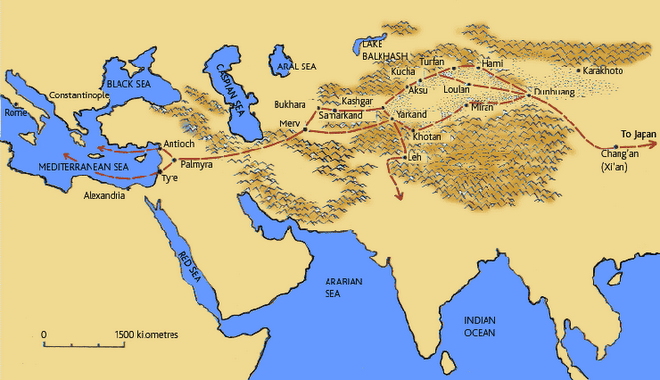
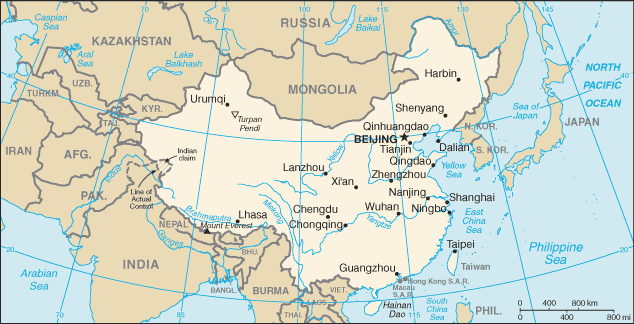

No comments:
Post a Comment